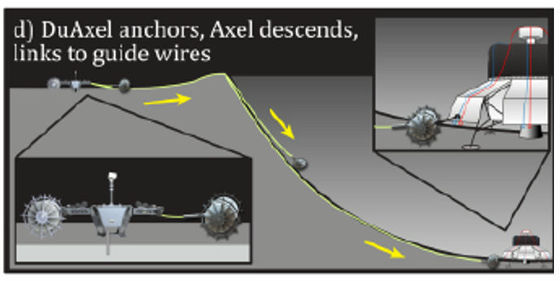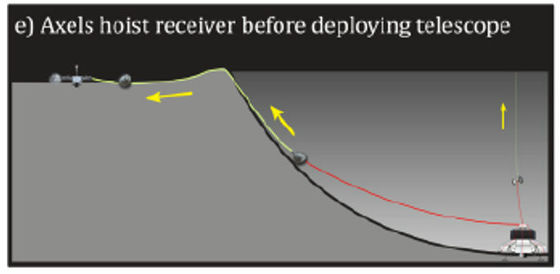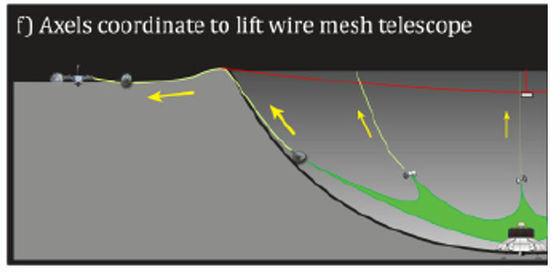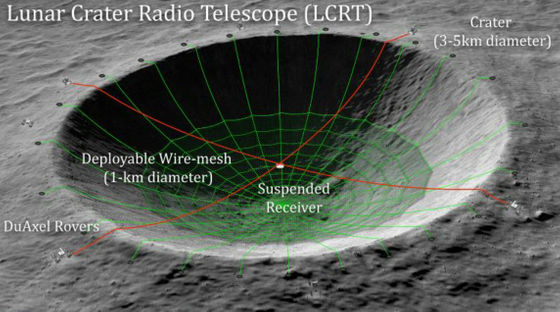NASA Announces Project to Turn Lunar Crater into a Giant Radio Telescope

By Saptarshi Bandyopadhyay
NASA has announced a project to 'turn the crater behind the moon into a
Lunar Crater Radio Telescope (LCRT) on the Far-Side of the Moon | NASA
https://www.nasa.gov/directorates/spacetech/niac/2020_Phase_I_Phase_II/lunar_crater_radio_telescope/
NASA Reveals Wild Project For Turning a Moon Crater Into a Radio Telescope
https://www.sciencealert.com/check-out-this-amazing-plan-to-turn-a-crater-on-the-far-side-of-the-moon-into-a-radio-telescope
NASA LCRT | NASA Might Build a Radio Telescope on the Moon
https://www.popularmechanics.com/space/moon-mars/a32086207/nasa-radio-telescope-moon/
When the radio telescope is installed on the surface of the moon, it is possible to measure wavelengths and frequencies that cannot be detected by the earth because it is not blocked by the thick ionosphere of the earth and various radio noises existing on the earth. The 'Moon Crater Radio Telescope (LCRT)' project announced by NASA on April 8, 2020 is a plan to utilize the shape of the crater on the moon as the base of a parabolic antenna and 'make the crater itself a radio telescope.' is.
In this plan, first, a crater with a shape and size suitable for a parabolic antenna will be selected from the back side of the moon. The size of the crater is 3km to 5km in diameter, and the reason for selecting the crater on the back side of the moon is that the crater on the side facing the earth interferes with the radio noise emitted from the earth.

Next, an unmanned lander loaded with a receiver that amplifies and detects radio waves is sent to the center of the crater, and a lander

The unmanned lander automatically deploys the building materials for LCRT.

The outer edge lander deploys the DuAxel, and each DuAxel moves to the appropriate position on the outer edge. After each DuAxel is fixed themselves on the outer edge,

DuAxel winds up the wire and collects the hoist.
The hoist pulls the wire mesh out of the central lander and then suspends the receiver with wires. Now, the receiver is placed in the center of the crater, and the wire mesh that forms the parabolic antenna is placed around it.

The LCRT at the time of completion looks like this. The red wire hangs the receiver in the center. The diameter of the parabolic antenna part by the wire mesh drawn in green will be 1 to 5 km.

As mentioned above, the diameter of LCRT is expected to be at least 1 km, and the largest radio telescope on the earth ' FAST ' has a diameter of 500 m, so if LCRT is realized, it will be 'the largest aperture type radio telescope in the solar system'. ..
There are many orbiting satellites in Earth's orbit, making it increasingly difficult to receive signals from space. LCRT is capable of receiving low-frequency signals of 6 to 30 MHz, which cannot be received on the earth, and is expected to bring further progress to space research.
According to science news site Science Alert, NASA has invested $ 125,000 in development funds and set a nine-month deadline to determine if the project is feasible.
Technically, a project to install a radio telescope on the moon has already been implemented. A project 'NCLE ' to receive low-frequency signals by linking a small low-frequency spectrometer installed by the Chinese lunar probe ' Chang'e 4 ' and a low-frequency probe in the lunar orbit with the Netherlands The Chinese team started on May 25, 2018.
Related Posts:







